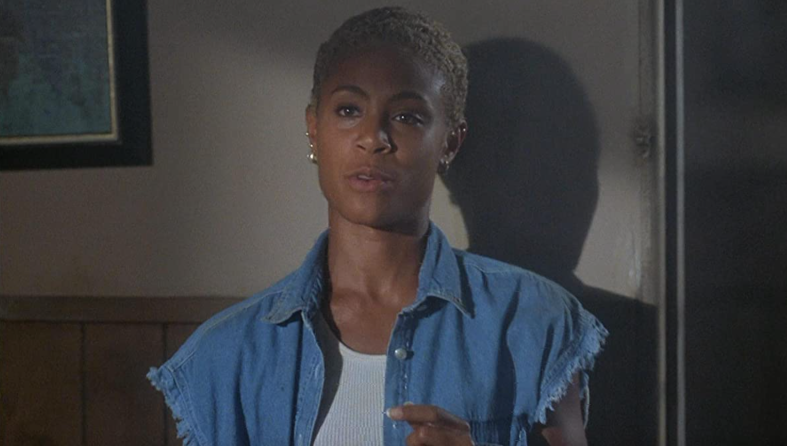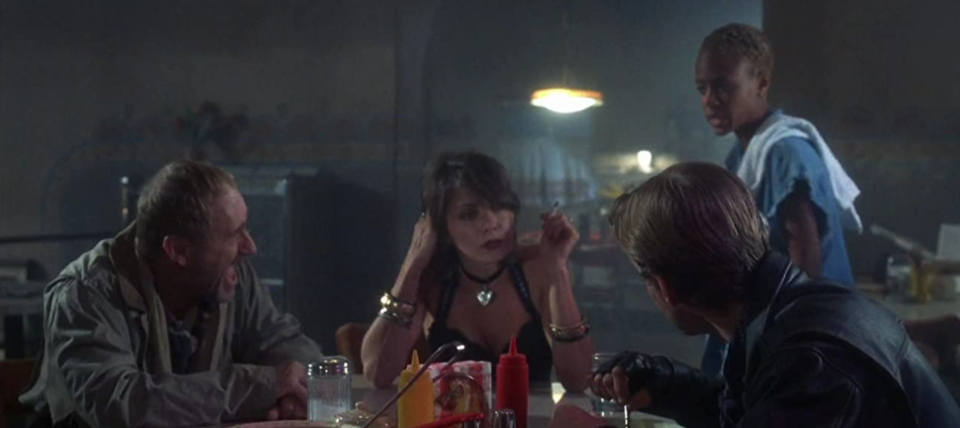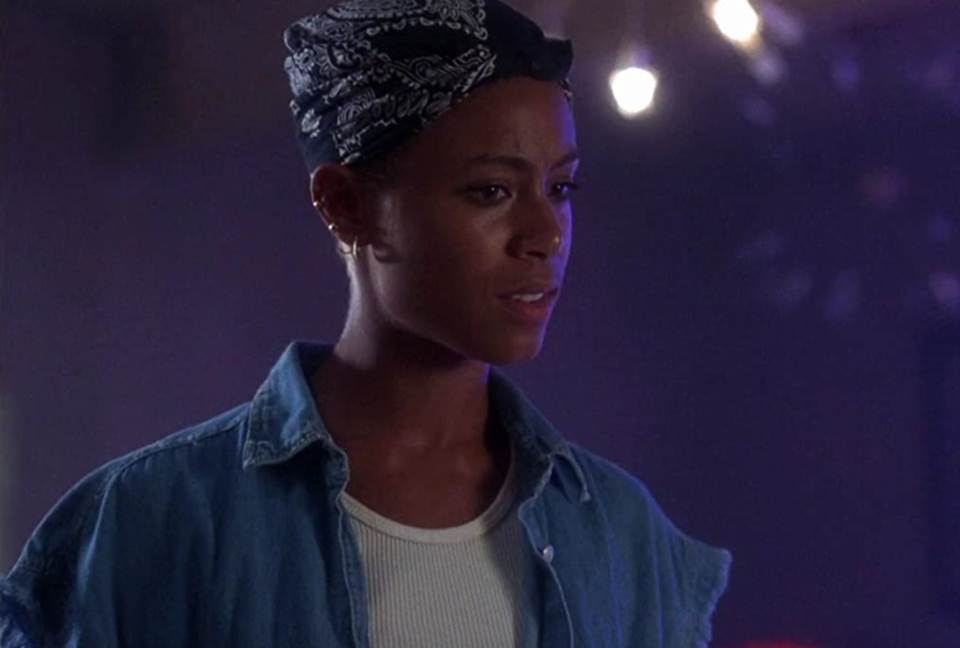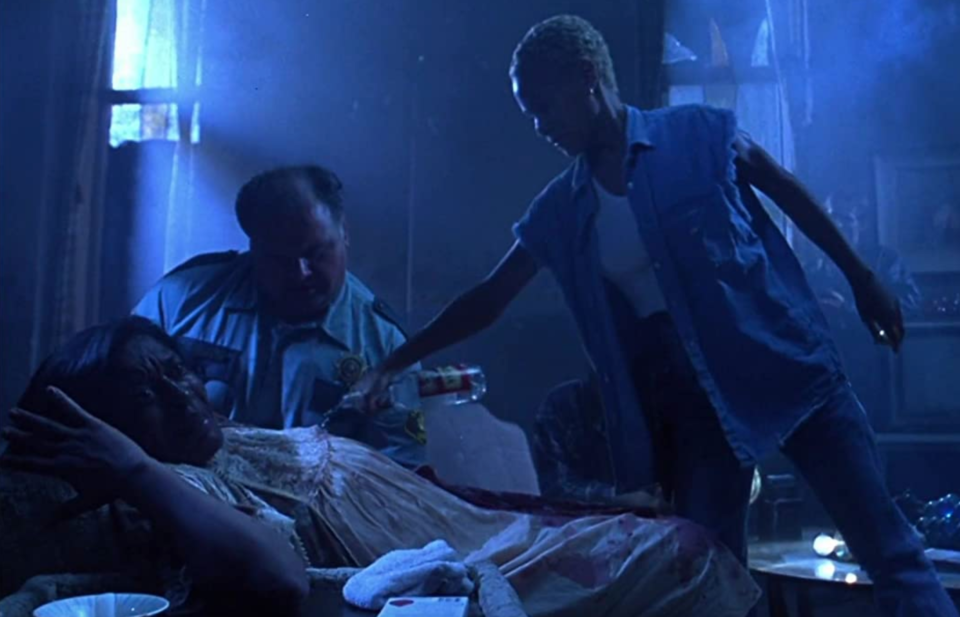Jeryline Bascombe: Demon Knight, Final Girl, and Savior of the World [Matriarchy Rising]

The 1990s have a bit of a dubious reputation in the horror genre. Depending on who you ask, the last decade of the 20th century is either a barren horror wasteland with a few bright spots or the decade that birthed some of the greatest horror films of all time. While the quality of 90s genre films may be up for debate, there’s no doubt about the decade’s lack of diversity.
Jada Pinkett Smith describes this frustrating scarcity of non-white characters as Maureen Evans in the opening scene of Scream 2. While this horror sequel does attempt to diversify its cast, the main characters are all white and its few characters of color are either supportive best friends or early victims. In addition to starring in one of the best slasher openings of all time, Pinkett has another impressive distinction: she is one of horror’s few Black Final Girls. As Jeryline in Tales from the Crypt: Demon Knight, she not only survives until the end of the film, but saves all of humanity in the process.
On a lonely road in rural Wormwood, New Mexico, a powerful demon known as the Collector (Billy Zane) chases Frank Brayker (William Sadler) in search of an ancient artifact said to contain the blood of Christ. After a fiery car crash, Brayker takes refuge in a decommissioned church now serving as a boarding house. The Collector bombards the building and its residents with his demonic minions hoping to gain possession of a key that will allow him to unleash hell on earth. As the last in a line of eternal guardians, Brayker must pass on the task of protecting the key to its next guardian, Jeryline, an ex-convict on work release. As the newest Demon Knight, she must square off against the Collector in a battle over the continuation of life as we know it.
Tales from the Crypt: Demon Knight is a surprisingly progressive tale of female leadership that places non-white characters at the core of the story. Written in 1987, the original script passed through many hands before making its way to director Ernest R. Dickerson who had previously worked as the cinematographer on Spike Lee’s early films and was best known at the time for directing the crime drama, Juice. Adding a framing narrative that features the crypt-keeper as a powerful Hollywood director, Dickerson repackaged the story as the first feature film spin-off from the HBO horror anthology series Tales from the Crypt. When studio executives originally wanted Cameron Diaz to star as Jeryline, Dickerson pushed for his ideal star Pinkett Smith and notes, “It was a great cast. I was also happy to do the first film where an African-American woman saves the world.”

When we first meet the residents of the run-down boarding house, Jeryline does not seem like our probable Final Girl. After decades of watching sensitive young white women defeat the masked killers in slasher films, we’ve been conditioned to pinpoint the soft-spoken Cordelia (Brenda Bakke) as the most likely character to survive until the end of the film. As a lonely sex worker, she seems to be the empathetic core of the story, caring for her sad-sack client Wally (Charles Fleischer) even though she pines for alpha male Roach (Thomas Haden Church). Trapped in a toxic love triangle, Cordelia accepts the Collector’s manipulative offer and becomes a demon herself, murdering Wally after luring him into her bedroom.
Though she is not the final girl in Demon Knight, Dickerson doesn’t shame Cordelia for her profession and presents her as a character worthy of our sympathy. After she’s been rejected and assaulted by the cruel and selfish Roach, the Collector preys on her weakened state with a honey-voiced plea to let him into the house. Appealing to her desire for respect and love, the Collector sees beyond her kinky tools and perpetually stained sheets and describes a young woman desperate to be loved for who he is rather than the pleasure she provides. Though the Collector eventually betrays her, his compassionate description of Cordelia’s relatable mindset allows the audience to see past her maligned profession and empathize with her as well.

When we first meet Jeryline in Demon Knight, she seems to be the embodiment of a racial stereotype. As a convict on a work release program, she fills the roles of maid, handyman, concierge, and cook to keep herself out of prison. Jeryline even looks the part of a criminal with her torn denim shirt, white tank top, and blue bandana. Her aunt and boss, Irene (CCH Pounder), is constantly giving her more work to do and complaining about her laziness. Jeryline responds with a snarky and reluctant attitude, though both women soften toward each other as the night wears on. At first glance, her characterization reifies racial stereotypes in which Black people are depicted as lazy and untrustworthy. But throughout the film, Jeryline dismantles these generalizations and proves to be the most capable person in the house.
Casting Pounder in the role of boarding house manager removes the racial element in this working relationship. Rather than shiftless, Jeryline seems to be the only one working to maintain a busy household. What Irene perceives as lazy is really a struggle to get an unmanageable amount of work done. For Irene’s part, she remarks that if not for her, Jeryline would either be in jail or dead. Perhaps her insistence that Jeryline stays busy masks a worry that with idle hands, Jeryline will fall back into old habits. Though their relationship often reads as combative, the two women do seem to care about each other. With demons surrounding the house, Irene suggests the two women make coffee together rather than continuing to demand Jeryline do all the work.

The audience might not pinpoint Jeryline as our final girl, but Brayker sees her potential right away. Jeryline seems to feel this connection as well and though Brayker holds a knife to her throat when threatened by the police, she tells him she was never really afraid he would hurt her. Brayker lets her go almost immediately and seemingly only holds her hostage because she happens to be standing closest to him. He gives her a heartfelt apology during a quiet moment and the two begin to build mutual respect.
Upon learning that Jeryline has previously served time, Brayker asks about her conviction but quickly assures her that he is not passing judgment. Jeryline tells us that she was imprisoned for stealing, but we never learn anything more about what she did. Dickerson treats it as a non-issue, a piece of her past rather than a defining characteristic.
As we learn more about the artifact and its guardians, we discover that it has always been protected by those perceived as criminals. In flashbacks we see that the blood of Christ was first collected by a thief, preserving the holy liquid as it dripped from the cross at the scene of the holy crucifixion. Brayker is also treated as a criminal by the ill-fated Wormwood police and his role as the artifact’s guardian causes him to live a nomadic life constantly at odds with the law.
By giving these marginalized characters the responsibility of protecting the world, Dickerson tells an inspiring story of redemption. His cast of misfits is not defined by the mistakes of their past, but by their present actions showing that even those of us discarded by society can still prove capable of saving the world.
The Collector also offers Irene and Jeryline tempting deals in exchange for the artifact. Having lost part of her arm in an earlier attack, Irene is tempted with the restoration of her health if she permits the demon to enter the house. She responds by flipping him off with her missing middle finger and later detonates a suicide vest, sacrificing her own life to destroy as many demons as possible. Jeryline repeatedly puts herself in danger to save others including her beloved cat, becoming the next in a long tradition of Final Girls protecting feline companions.
Despite this bravery, the Collector offers her a deal as well, promising a life of excitement and eternal youth if she just gives him the key. She resists and spits in his face, refusing to sell out humanity for her own selfish gains. These choices are not only brave, but smart as all of the Collector’s promises turn out to be lies. By contrast, nearly everyone else in the house gives into his persuasive appeals and pays a steep price for their naivete.

Once Brayker has passed on his duties as the artifact’s protector, The Collector offers Jeryline even more power. Having become smitten with the resourceful young woman, he attempts to profess his love for her and offers her a seat by his side as a leader of hell on earth. He does seem to genuinely admire her though this may stem from a desire to increase his status in hell with this unlikely alliance. Jeryline resists his advances, holding blood from the artifact in her mouth until the perfect moment presents itself. She once again spits in his face this time with the holy blood, revealing the Collector’s true demonic form and causing his destruction.
Jeryline has now become the sole protector of humanity. Along with her beloved cat, she boards a bus and leaves New Mexico for parts unknown, but not before setting eyes on the new Collector (Mark David Kennerly). A handsome Black man carrying the same case as the previous collector declines to board the bus and follows her on foot, setting up a cat-and-mouse game for years to come.
By surviving the hellish night, Jeryline has become not only the film’s Final Girl, but a character Robin R. Means Coleman would describe as an Enduring Woman. In her seminal book Horror Noire: Blacks in American Horror Films from the 1890s to Present, Coleman defines this character as a survivor who emerges victorious only to realize that the threat is ongoing. Jeryline’s battle will not be against racialized oppression and her new nemesis is also a character of color. However, unlike her white counterparts, Jeryline will not have the chance to rest and recuperate. With a new Collector hot on her heels, she must continue an ongoing battle for decades to come.
In the closing vignette, we learn that Jeryline is living a wonderful life traveling the world. Though this nomadic existence is surely more exciting than her repetitive job in Wormwood, we can only hope that the newest Demon Knight has a chance to enjoy her newfound freedom in between battles with the Collector. Though often dismissed as a silly gore-fest, Tales from the Crypt: Demon Knight holds up surprisingly well with its nuanced characters and a poignant lesson about empathy and redemption. In addition to a subtle critique of racial stereotypes and the roles of non-white characters in the horror genre, the film gives us a massively underrated Black final girl who could easily rival anyone who has come before or after.
Categorized:Editorials Matriarchy Rising News

